





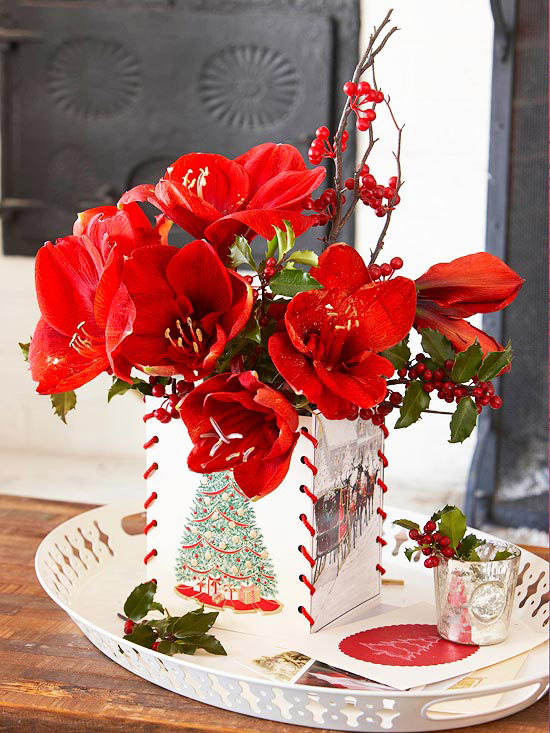
When a showy amaryllis blooms, the explosion is visible from everywhere in a room. Bursting forth from tall stems, these robust plants grow to heights of 2 feet and produce three or four blossoms per stalk. From one bulb, a single, double, or triple set of stalks can emerge, all of which are crowned with flowers. The blooms are magnificent and can reach a width of 8-10 inches. Amaryllis requires no cold storage -- as most other forced bulbs do -- and they need only be planted in a pot, placed in a sunny window, and watered.
Amaryllis are available in a wide range of colors and sizes. Look for bulbs that bloom in shades of red, orange, pink, yellow, or white, with single- or double-flower forms. Wild-looking species types are also available, as are miniature varieties that stay around 1 foot tall. Although many sources sell amaryllis prepotted -- complete with container, soil, and bulb -- it's easy to pot yourself. Either way, you will be rewarded with stunningly spectacular blooms.
On average, amaryllis needs about 6-7 weeks to bloom if you start with a dormant bulb. That means if you want your amaryllis to bloom around the holidays, plant it the first or second week of November. Some bulbs begin to sprout while still sitting on the store shelf -- one reason why some bloom more quickly than expected.
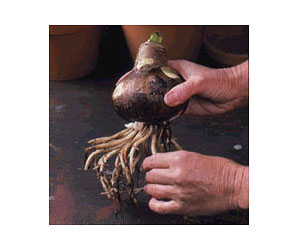
1. Select a large, firm bulb that is free of bruises or blemishes with a healthy root system. Gently untangle and separate the roots before planting. The bigger the bulb, the greater chance you have of getting multiple stalks of bloom. If you don't plan on potting up the bulb right away, store it in a well-ventilated, cool, dark spot at a temperature between 50 and 60 degrees F.
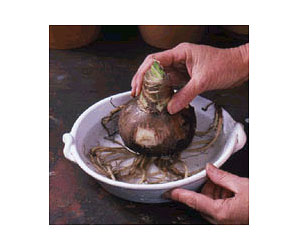
2. Soak roots in a shallow pan of lukewarm water for 3-4 hours before planting the bulb.
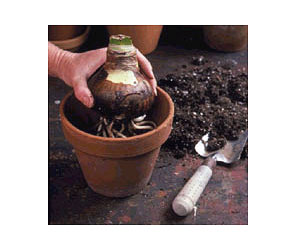
3. Select a pot that is twice as tall as the bulb to allow ample room for proper root growth. Suspend the bulb over the pot, then fill the pot with a well-drained potting soil mixture high in sphagnum peat moss or vermiculite. Leave two-thirds of the bulb above the soil. Make sure the bulb does not touch the edge of the pot or another bulb.
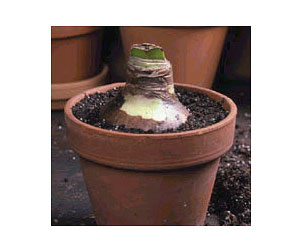
4. Tap the soil down around the bulb and water, taking care not to soak the bulb. Place the potted amaryllis in a sunny window with a temperature of 70-75 degrees F. Water sparingly until the bulb begins to sprout, then water the plant enough to maintain soil moisture.
If you decide to keep the bulb growing for blooms the next year, move it to a well-lit spot and keep watering the bulb. Add an occasional dose of general-purpose or houseplant fertilizer to keep the plant healthy.
Once the weather warms up, you can put amaryllis out on a patio or deck for the summer. Amaryllis can take some direct sun -- morning sun, preferably -- but it isn't really a heat-loving plant; avoid hot, afternoon sun. Filtered sun or partly sunny conditions are best. Or you can keep the plant indoors if you like; just make sure it receives bright light.
Continue to water and fertilize the plant a couple more times through the summer. In late summer or early fall, amaryllis leaves will turn brown, signaling it's a good time to put the bulb in the basement for a seasonal nap. Cease watering, put the plant in a cool, dry, dark place. Allow any remaining leaves to die back, which they will do as the soil dries out. After a few weeks of dormancy, the bulb should begin pushing a new flower stalk, starting the whole cycle all over again.
Well-cared-for amaryllis increase in size each year, and also send out new bulbs. Eventually, a potted amaryllis can become an impressive specimen, producing many flower stalks. Don't be too eager to repot the bulbs, though. They like "tight shoes," as the saying goes. Let them get crowded -- they can remain in the same pot for several years. And if you want to share your amaryllis with a friend, just split off one of the daughter bulbs (while dormant) and pot it up in a new container.
Copyright © www.100flowers.win Botanic Garden All Rights Reserved